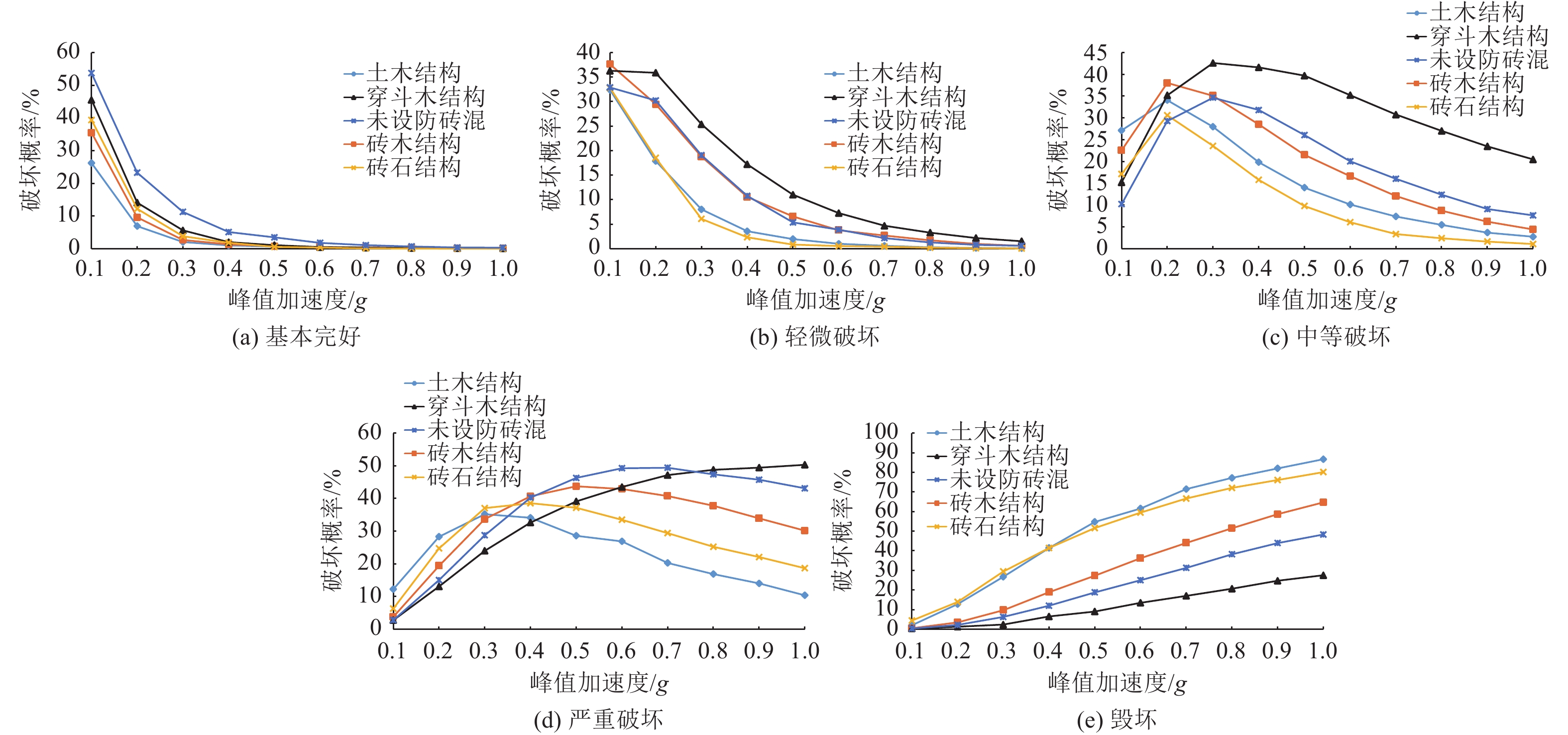Study on the Seismic Vulnerability of Western Sichuan Rural Buildings Based on Seismic Damage Data
-
摘要: 基于汶川地震等6次典型破坏性地震的震害调查资料,采用基于震害数据调查的经验分析法得出了川西地区农居建筑基于地震烈度的地震易损性矩阵,并采用房屋震害矩阵曲线化分析方法转化计算得出该地区基于地震峰值加速度的地震易损性矩阵。通过分析该地区5类农居建筑的破坏概率和对易损性指数的计算分析,得出不同结构农居建筑的抗震性能排序和抗倒塌能力排序,即穿斗木结构的抗震性能最好,土木结构的抗震性能最差,其余结构类型的抗震性能顺序依次是未设防砖混结构、砖木结构、砖石结构。同时,穿斗木结构的抗倒塌性能最好,然后依次是未设防砖混结构和砖木结构,而土木结构和砖石结构是抗倒塌性能最差的2种结构类型。Abstract: Based on the seismic damage data of six typical destructive earthquakes such as Wenchuan earthquake,the seismic vulnerability matrix of rural buildings in western Sichuan Province based on seismic intensity is obtained by empirical analysis on the ground of seismic damage data.Then the seismic vulnerability matrix based on peak acceleration is obtained by using the curvilinear analysis method of building damage matrix.Through the calculation and analysis of the damage probability and the vulnerability index,the order of seismic performance of different structures is obtained.In Western Sichuan area,the seismic performance of the timber structure through bucket is best,followed by the unfortified masonry structure,the brick and wood structure,the masonry structure and the civil structure.The anti-collapse performance of the timber structure through bucket is best, followed by the unfortified masonry structure and the brick and wood structure,the civil structure and the masonry structures are the two worst structure types.
-
表 1 川西地区各结构类型农居震害调查数据样本数量
Table 1. The number of earthquake damage survey data of rural buildings of different structural types in western Sichuan
地震名称及烈度 样本数量/个 土木结构 砖木结构 穿斗木结构 砖石结构 未设防砖混 汶川8.0级地震 Ⅵ 36 48 24 38 57 Ⅶ 96 99 47 79 98 Ⅷ 89 102 32 63 122 Ⅸ 45 57 21 41 96 Ⅹ 12 16 8 7 33 攀枝花6.1级地震 Ⅵ 18 21 11 10 22 Ⅶ 11 15 6 5 19 Ⅷ 6 8 3 2 12 芦山7.0级地震 Ⅵ 39 47 21 38 67 Ⅶ 51 58 28 45 72 Ⅷ 31 45 19 20 49 Ⅸ 11 14 9 12 35 康定6.3级地震 Ⅵ 17 19 12 11 21 Ⅶ 15 14 7 8 17 Ⅷ 12 11 4 6 15 九寨沟7.0级地震 Ⅵ 35 42 20 31 69 Ⅶ 52 61 29 46 73 Ⅷ 33 46 18 23 50 Ⅸ 12 13 8 11 34 马尔康6.0级震群 Ⅵ 14 16 9 10 18 Ⅶ 12 13 3 7 16 Ⅷ 11 10 2 4 13 表 2 土木结构基于烈度易损性矩阵
Table 2. Earthquake vulnerability matrix based on seismic intensity of mud-wood structures
破坏等级 破坏概率/% Ⅵ Ⅶ Ⅷ Ⅸ Ⅹ 基本完好 56 19 5 0 0 轻微破坏 29 36 11 3 0 中等破坏 13 23 34 21 1 严重破坏 2 19 33 30 12 毁坏 0 3 17 46 87 表 3 砖木结构基于烈度易损性矩阵
Table 3. Earthquake vulnerability matrix based on seismic intensity of brick-wood structures
破坏等级 破坏概率/% Ⅵ Ⅶ Ⅷ Ⅸ Ⅹ 基本完好 64 30 7 0 0 轻微破坏 28 38 25 9 0 中等破坏 7 27 36 19 8 严重破坏 1 5 25 51 28 毁坏 0 0 7 21 64 表 4 穿斗木结构基于烈度易损性矩阵
Table 4. Earthquake vulnerability matrix of through type timber frame structures
破坏等级 破坏概率/% Ⅵ Ⅶ Ⅷ Ⅸ Ⅹ 基本完好 73 44 10 0 0 轻微破坏 24 33 34 13 1 中等破坏 3 20 38 31 28 严重破坏 0 3 17 44 45 毁坏 0 0 1 12 26 表 5 砖石结构基于烈度易损性矩阵
Table 5. Earthquake vulnerability matrix based on seismic intensity of brick and stone structures
破坏等级 破坏概率/% Ⅵ Ⅶ Ⅷ Ⅸ Ⅹ 基本完好 69 29 8 0 0 轻微破坏 21 35 11 0 0 中等破坏 10 17 20 13 0 严重破坏 0 12 36 36 18 毁坏 0 7 25 51 82 表 6 未设防砖混结构基于烈度易损性矩阵
Table 6. Earthquake vulnerability matrix based on seismic intensity of unfortified masonry structures
破坏等级 破坏概率/% Ⅵ Ⅶ Ⅷ Ⅸ Ⅹ 基本完好 78 53 14 2 0 轻微破坏 21 29 26 6 0 中等破坏 1 15 36 22 7 严重破坏 0 3 19 54 41 毁坏 0 0 5 16 52 表 7 基于PGA的不同结构不同破坏状态下的易损性曲线双参数θ和β
Table 7. The θ and β of the vulnerability curve of different structures under different failure states based on PGA
结构类型 轻微破坏LS1 中等破坏LS2 严重破坏LS3 毁坏LS4 θ β θ β θ β θ β 土木结构 0.070 0.696 0.126 0.675 0.239 0.732 0.467 0.694 砖木结构 0.083 0.703 0.171 0.739 0.346 0.678 0.784 0.720 穿斗木结构 0.102 0.669 0.212 0.726 0.519 0.848 1.730 0.926 砖石结构 0.092 0.689 0.153 0.547 0.238 0.613 0.491 0.845 未设访砖混 0.119 0.770 0.223 0.623 0.396 0.660 1.031 0.786 表 8 土木结构基于峰值加速度易损性矩阵
Table 8. Earthquake vulnerability matrix based on peak acceleration of mud-wood structures
PGA/g 破坏概率/% 基本完好DS0 轻微破坏DS1 中等破坏DS2 严重破坏DS3 毁坏DS4 0.01 99.08 0.9 0.02 0 0 0.10 26.21 32.38 27.14 12.26 2.01 0.20 6.93 17.89 34.07 28.31 12.8 0.30 2.04 8.03 27.97 35.22 26.74 0.40 1.01 3.58 19.84 34.1 41.47 0.50 0.67 1.98 14.01 28.6 54.74 0.60 0.39 1.02 10.13 26.88 61.58 0.70 0.24 0.61 7.38 20.28 71.49 0.80 0.13 0.3 5.46 16.89 77.22 0.90 0.09 0.17 3.68 14.01 82.05 1.00 0.05 0.12 2.73 10.38 86.72 表 9 砖木结构基于峰值加速度易损性矩阵
Table 9. Earthquake vulnerability matrix based on peak acceleration of brick-wood structures
PGA/g 破坏概率/% 基本完好DS0 轻微破坏DS1 中等破坏DS2 严重破坏DS3 毁坏DS4 0.01 99.32 0.67 0.01 0.00 0.00 0.10 35.51 37.62 22.57 3.80 0.50 0.20 9.59 29.47 38.05 19.40 3.49 0.30 2.70 18.80 35.09 33.69 9.72 0.40 1.37 10.56 28.50 40.67 18.90 0.50 0.80 6.60 21.53 43.76 27.31 0.60 0.50 3.78 16.62 42.91 36.19 0.70 0.41 2.71 12.09 40.76 44.03 0.80 0.25 1.72 8.71 37.81 51.51 0.90 0.15 1.01 6.20 33.92 58.72 1.00 0.10 0.61 4.40 30.18 64.71 表 10 穿斗木结构基于峰值加速度易损性矩阵
Table 10. Earthquake vulnerability matrix of through type timber frame structures
PGA/g 破坏概率/% 基本完好DS0 轻微破坏DS1 中等破坏DS2 严重破坏DS3 毁坏DS4 0.01 99.78 0.22 0.00 0.00 0.00 0.10 45.31 36.29 15.22 2.78 0.40 0.20 14.11 36.09 35.40 13.09 1.31 0.30 5.62 25.39 42.60 24.01 2.38 0.40 2.01 17.22 41.61 32.66 6.50 0.50 1.10 11.02 39.71 39.12 9.05 0.60 0.50 7.28 35.23 43.51 13.48 0.70 0.35 4.70 30.77 47.16 17.02 0.80 0.22 3.29 27.03 48.79 20.67 0.90 0.15 2.20 23.48 49.45 24.72 1.00 0.11 1.54 20.48 50.32 27.55 表 11 砖石结构基于峰值加速度易损性矩阵
Table 11. Earthquake vulnerability matrix based on peak acceleration of brick and stone structures
PGA/g 破坏概率/% 基本完好DS0 轻微破坏DS1 中等破坏DS2 严重破坏DS3 毁坏DS4 0.01 99.18 0.81 0.01 0.00 0.00 0.10 39.37 32.78 17.14 6.31 4.40 0.20 12.20 18.53 30.61 24.74 13.92 0.30 3.81 6.10 23.58 37.05 29.46 0.40 1.85 2.35 15.79 38.56 41.45 0.50 0.58 0.86 9.78 37.16 51.62 0.60 0.37 0.56 6.06 33.49 59.52 0.70 0.12 0.45 3.34 29.41 66.68 0.80 0.07 0.21 2.39 25.22 72.11 0.90 0.04 0.12 1.63 22.09 76.12 1.00 0.02 0.06 1.07 18.68 80.17 表 12 未设防砖混结构基于峰值加速度易损性矩阵
Table 12. Earthquake vulnerability matrix based on peak acceleration of unfortified masonry structures
PGA/g 破坏概率/% 基本完好DS0 轻微破坏DS1 中等破坏DS2 严重破坏DS3 毁坏DS4 0.01 99.55 0.45 0.00 0.00 0.00 0.10 53.71 32.89 10.22 2.79 0.39 0.20 23.26 30.23 29.28 15.04 2.19 0.30 11.26 19.07 34.65 28.74 6.28 0.40 5.11 10.78 31.82 40.28 12.01 0.50 3.48 5.38 26.06 46.30 18.78 0.60 1.80 3.89 20.04 49.26 25.01 0.70 1.09 2.18 16.03 49.42 31.28 0.80 0.71 1.29 12.38 47.38 38.24 0.90 0.39 0.80 9.09 45.75 43.97 1.00 0.31 0.62 7.63 43.11 48.33 表 13 川西地区基于峰值加速度易损性指数
Table 13. The vulnerability indexs based on peak acceleration in different zones of western Sichuan
参数 结构类型 土木结构 砖木结构 穿斗木结构 砖石结构 未设防砖混结构 易损性指数 1.50 1.29 1.04 1.49 1.17 -
陈波, 温增平, 赵文哲, 2018. 基于地震动参数的房屋震害矩阵曲线化分析方法. 地震研究, 41(4): 613—621.Chen B. , Wen Z. P. , Zhao W. Z. , 2018. Curve fitting approach to obtain fragility curve from building damage matrix based on the seismic ground motion parameters. Journal of Seismological Research, 41(4): 613—621. (in Chinese) 何玉林, 黎大虎, 范开红等, 2002. 四川省房屋建筑易损性研究. 中国地震, 18(1): 52—58He Y. L. , Li D. H. , Fan K. H. , et al. , 2002. Research on the seismic vulnerabilities of building structure in Sichuan region. Earthquake Research in China, 18(1): 52—58. (in Chinese) 胡少卿, 孙柏涛, 王东明等, 2007. 经验震害矩阵的完善方法研究. 地震工程与工程振动, 27(6): 46—50Hu S. Q. , Sun B. T. , Wang D. M. , et al. , 2007. Approach to making empirical earthquake damage matrix. Journal of Earthquake Engineering and Engineering Vibration, 27(6): 46—50. (in Chinese) 李静, 陈健云, 温瑞智, 2012. 框架结构群体震害易损性快速评估研究. 振动与冲击, 31(7): 99—103Li J. , Chen J. Y. , Wen R. Z. , 2012. Fast evaluation of seismic damage group vulnerability for a frame. Journal of Vibration and Shock, 31(7): 99—103. (in Chinese) 林皓鋆, 潘文, 张健等, 2019. 基于烈度差的云南省城市地区建筑易损性研究. 建筑结构, 49(8): 33—36Lin H. J. , Pan W. , Zhang J. , et al. , 2019. Study on vulnerability of buildings in urban areas of Yunnan province based on intensity difference. Building Structure, 49(8): 33—36. (in Chinese) 刘如山, 胡少卿, 邬玉斌等, 2009. 基于地震动参数的结构易损性表达方法研究. 地震工程与工程振动, 29(6): 102—107Liu R. S. , Hu S. Q. , Wu Y. B. , et al. , 2009. Research on structure vulnerability expression way based on seismic ground motion parameters. Journal of Earthquake Engineering and Engineering Vibration, 29(6): 102—107. (in Chinese) 马玉宏, 赵桂峰, 陈小飞等, 2015. 村镇建筑基于性态抗震设防的地震保险费率厘定. 地震研究, 38(3): 461—466Ma Y. H. , Zhao G. F. , Chen X. F. , et al. , 2015. Earthquake insurance premium rate of rural buildings based on performance-based seismic-design. Journal of Seismological Research, 38(3): 461—466. (in Chinese) 邱舒睿, 高惠瑛, 2015. 青海省农居地震灾害易损性研究. 震灾防御技术, 10(4): 969—978Qiu S. R. , Gao H. Y. , 2015. The research of rural dwelling's seismic vulnerability in Qinghai. Technology for Earthquake Disaster Prevention, 10(4): 969—978. (in Chinese) 孙柏涛, 陈洪富, 闫培雷等, 2014. 南北地震带房屋建筑抗震能力分区特征研究——以四川省为例. 土木工程学报, 47(S1): 6—10Sun B. T. , Chen H. F. , Yan P. L. , et al. , 2014. Research on zoned characteristics of building seismic capacity along North South seismic belt-take Sichuan province as an example. China Civil Engineering Journal, 47(S1): 6—10. (in Chinese) 姚新强, 2016. 天津农居易损性与抗震能力分布研究. 哈尔滨: 中国地震局工程力学研究所.Yao X. Q. , 2016. Analysis of Tianjin rural residential vulnerability and seismic capacity distribution. Harbin: Institute of Engineering Mechanics, China Earthquake Administration. (in Chinese) 周光全, 谭文红, 施伟华等, 2007. 云南地区房屋建筑的震害矩阵. 中国地震, 23(2): 115—123Zhou G. Q. , Tan W. H. , Shi W. H. , et al. , 2007. Seismic hazard matrix of house construction in Yunnan. Earthquake Research in China, 23(2): 115—123. (in Chinese) Casciati F., Faravelli L., 1989. Seismic vulnerability via knowledge based expert systems. In: Brebbia C A, ed., Structural Repair and Maintenance of Historical Buildings. Southampton: Computational Mechanics Pub, 299—307. -




 下载:
下载:


